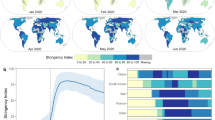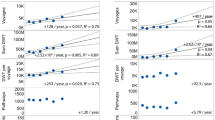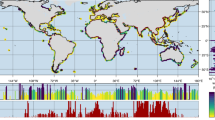Abstract
Socioeconomic factors, including population growth, global trade and the worldwide transport of materials, interact with environmental drivers to determine the sustainability of natural systems. We focus on the global shipping network, which is central to invasive species spread worldwide. We explain 90% of the variation in global shipping traffic and a twofold increase in shipping using basic socioeconomic indicators and a temporal validation set. Combining our model with global economic development scenarios, we project global maritime traffic to increase by 240–1,209% by 2050. Integrating our predictions with global climate change projections and shipping-mediated invasion models, we forecast invasion risk to surge in middle-income countries, particularly in Northeast Asia. Shipping growth will have a far greater effect on marine invasions than climate-driven environmental changes: while climate change might actually decrease the average probability of invasion, the emerging global shipping network could yield a 3- to 20-fold increase in global invasion risk.
This is a preview of subscription content, access via your institution
Access options
Access Nature and 54 other Nature Portfolio journals
Get Nature+, our best-value online-access subscription
$29.99 / 30 days
cancel any time
Subscribe to this journal
Receive 12 digital issues and online access to articles
$119.00 per year
only $9.92 per issue
Buy this article
- Purchase on Springer Link
- Instant access to full article PDF
Prices may be subject to local taxes which are calculated during checkout




Similar content being viewed by others
Code availability
Code underlying the results will be made available upon request.
Data availability
Historical GDP and population data were obtained from the World Bank Databank (http://databank.worldbank.org/), and forecasted values are accessible through the IIASA SSP database (https://tntcat.iiasa.ac.at/SspDb/). Data on inter-country distance, trade agreements, common language, common border and common colonial history are obtainable through the CEPII research centre’s GeoDist and Gravity datasets (http://www.cepii.fr/CEPII/en/bdd_modele/bdd_modele.asp). Data on historical ballast releases can be accessed through the NBIC Database (https://invasions.si.edu/nbic/search.html). Current and forecasted environmental variables used in this study are available from the AquaMaps Environmental Dataset (https://www.aquamaps.org/main/envt_data.php). Data on ship movements and attributes were purchased from IHS Sea-web, are used under license and cannot be publicly shared by the authors. However, these data can be purchased from IHS (https://maritime.ihs.com).
References
Carrasco, L. R., Chan, J., McGrath, F. & Nghiem, L. Biodiversity conservation in a telecoupled world. Ecol. Soc. 22, 24 (2017).
Riahi, K. et al. The shared socioeconomic pathways and their energy, land use, and greenhouse gas emissions implications: an overview. Glob. Environ. Change 42, 153–168 (2016).
Liu, J. et al. Framing sustainability in a telecoupled world. Ecol. Soc. 18, 26 (2013).
Review of Maritime Transport 2017 (United Nations, 2017).
Pimentel, D., Zuniga, R. & Morrison, D. Update on the environmental and economic costs associated with alien-invasive species in the United States. Ecol. Econ. 52, 273–288 (2005).
Hewitt, C. L., Gollasch, S. & Minchin, D. in Biological Invasions in Marine Ecosystems 117–131 (Springer, Berlin & Heidelberg, 2009).
Brockerhoff, E. G., Kimberley, M., Liebhold, A. M., Haack, R. A. & Cavey, J. F. Predicting how altering propagule pressure changes establishment rates of biological invaders across species pools. Ecology 95, 594–601 (2014).
Hudgins, E. J., Liebhold, A. M. & Leung, B. Predicting the spread of all invasive forest pests in the United States. Ecol. Lett. 20, 426–435 (2017).
Kaluza, P., Kölzsch, A., Gastner, M. T. & Blasius, B. The complex network of global cargo ship movements. J. R. Soc. Interface 7, 1093–1103 (2010).
Seebens, H., Schwartz, N., Schupp, P. J. & Blasius, B. Predicting the spread of marine species introduced by global shipping. Proc. Natl Acad. Sci. USA 113, 5646–5651 (2016).
Ware, C. et al. Climate change, non‐indigenous species and shipping: assessing the risk of species introduction to a high‐Arctic archipelago. Divers. Distrib. 20, 10–19 (2014).
Floerl, O., Rickard, G., Inglis, G. & Roulston, H. Predicted effects of climate change on potential sources of non‐indigenous marine species. Divers. Distrib. 19, 257–267 (2013).
Bellard, C., Cassey, P. & Blackburn, T. M. Alien species as a driver of recent extinctions. Biol. Lett. 12, 20150623 (2016).
Tournadre, J. Anthropogenic pressure on the open ocean: the growth of ship traffic revealed by altimeter data analysis. Geophys. Res. Lett. 41, 7924–7932 (2014).
Stopford, M. Maritime Economics 3e (Routledge, 2009).
Wang, M. The rise of container tonnage and port developments in East Asia. Bus. Manag. Stud. 1, 189–198 (2015).
Baldwin, R. & Taglioni, D. Gravity for Dummies and Dummies for Gravity Equations Working Paper 12516 (NBER, 2006).
Gómez-Herrera, E. Comparing alternative methods to estimate gravity models of bilateral trade. Empir. Econ. 44, 1087–1111 (2013).
Santos Silva, J. & Tenreyro, S. The log of gravity. Rev. Econ. Stat. 88, 641–658 (2006).
Seebens, H., Gastner, M. T. & Blasius, B. The risk of marine bioinvasion caused by global shipping. Ecol. Lett. 16, 782–790 (2013).
Nakicenovic, N. et al. Special Report on Emissions Scenarios (SRES) (IPCC, Cambridge Univ. Press, 2000).
Rounsevell, M. D. & Metzger, M. J. Developing qualitative scenario storylines for environmental change assessment. Wiley Interdiscip. Rev. Clim. Change 1, 606–619 (2010).
Wiebe, K. et al. Climate change impacts on agriculture in 2050 under a range of plausible socioeconomic and emissions scenarios. Environ. Res. Lett. 10, 085010 (2015).
Bijl, D. L., Bogaart, P. W., Kram, T., de Vries, B. J. & van Vuuren, D. P. Long-term water demand for electricity, industry and households. Environ. Sci. Pol. 55, 75–86 (2016).
Chen, K. et al. Impact of climate change on heat-related mortality in Jiangsu Province, China. Environ. Pollut. 224, 317–325 (2017).
Alfieri, L., Feyen, L., Dottori, F. & Bianchi, A. Ensemble flood risk assessment in Europe under high end climate scenarios. Glob. Environ. Change 35, 199–212 (2015).
Bradie, J., Pietrobon, A. & Leung, B. Beyond species-specific assessments: an analysis and validation of environmental distance metrics for non-indigenous species risk assessment. Biol. Invasions 17, 3455–3465 (2015).
Keller, R. P., Drake, J. M., Drew, M. B. & Lodge, D. M. Linking environmental conditions and ship movements to estimate invasive species transport across the global shipping network. Divers. Distrib. 17, 93–102 (2011).
Della Venezia, L., Samson, J. & Leung, B. The rich get richer: invasion risk across North America from the aquarium pathway under climate change. Divers. Distrib. 24, 285–296 (2018).
Leung, B., Springborn, M. R., Turner, J. A. & Brockerhoff, E. G. Pathway‐level risk analysis: the net present value of an invasive species policy in the US. Front. Ecol. Environ. 12, 273–279 (2014).
Westphal, M. I., Browne, M., MacKinnon, K. & Noble, I. The link between international trade and the global distribution of invasive alien species. Biol. Invasions 10, 391–398 (2008).
Steinberger, J. K., Krausmann, F. & Eisenmenger, N. Global patterns of materials use: a socioeconomic and geophysical analysis. Ecol. Econ. 69, 1148–1158 (2010).
Filippini, C. & Molini, V. The determinants of East Asian trade flows: a gravity equation approach. J. Asian Econ. 14, 695–711 (2003).
Oguledo, V. & MacPhee, C. R. Gravity models: a reformulation and an application to discriminatory trade arrangements. Appl. Econ. 26, 107–120 (1994).
Pyšek, P. et al. Geographical and taxonomic biases in invasion ecology. Trends Ecol. Evol. 23, 237–244 (2008).
Godfray, H. C. J. et al. Food security: the challenge of feeding 9 billion people. Science 327, 812–818 (2010).
Vörösmarty, C. J. et al. Global threats to human water security and river biodiversity. Nature 467, 555–561 (2010).
Chen, J. & Liu, X. Transport: Nicaragua Canal may not benefit shipping. Nature 533, 321 (2016).
Chen, J., Zeng, X. & Deng, Y. Environmental pollution and shipping feasibility of the Nicaragua Canal. Mar. Pollut. Bull. 113, 87–93 (2016).
Chan, F. T., Bailey, S. A., Wiley, C. J. & MacIsaac, H. J. Relative risk assessment for ballast-mediated invasions at Canadian Arctic ports. Biol. Invasions 15, 295–308 (2013).
Ho, J. The implications of Arctic sea ice decline on shipping. Mar. Policy 34, 713–715 (2010).
Miller, A. W. & Ruiz, G. M. Arctic shipping and marine invaders. Nat. Clim. Change 4, 413–416 (2014).
Melia, N., Haines, K. & Hawkins, E. Sea ice decline and 21st century trans‐Arctic shipping routes. Geophys. Res. Lett. 43, 9720–9728 (2016).
Smith, L. C. & Stephenson, S. R. New trans-Arctic shipping routes navigable by midcentury. Proc. Natl Acad. Sci. USA 110, E1191–E1195 (2013).
Lasserre, F. Case studies of shipping along Arctic routes. Analysis and profitability perspectives for the container sector. Transp. Res. Pt A 66, 144–161 (2014).
Lasserre, F. & Pelletier, S. Polar super seaways? Maritime transport in the Arctic: an analysis of shipowners’ intentions. J. Transp. Geogr. 19, 1465–1473 (2011).
Spalding, M. D. et al. Marine ecoregions of the world: a bioregionalization of coastal and shelf areas. AIBS Bull. 57, 573–583 (2007).
Rodrigue, J. P. & Notteboom, T. Foreland-based regionalization: integrating intermediate hubs with port hinterlands. Res. Transp. Econ. 27, 19–29 (2010).
Anderson, J. E. & Van Wincoop, E. Gravity with gravitas: a solution to the border puzzle. Am. Econ. Rev. 93, 170–192 (2003).
LeSage, J. P. & Pace, R. K. Spatial econometric modeling of origin–destination flows. J. Reg. Sci. 48, 941–967 (2008).
Xu, J., Wickramarathne, T. L. & Chawla, N. V. Representing higher-order dependencies in networks. Sci. Adv. 2, e1600028 (2016).
Stachowicz, J. J., Whitlatch, R. B. & Osman, R. W. Species diversity and invasion resistance in a marine ecosystem. Science 286, 1577–1579 (1999).
Levin, L. A. & Bridges, T. S. in Ecology of Marine Invertebrate Larvae 1–48 (CRC Press, Boca Raton, 1995).
Leung, B. et al. TEASIng apart alien species risk assessments: a framework for best practices. Ecol. Lett. 15, 1475–1493 (2012).
Davidson, I. et al. Mini-review: assessing the drivers of ship biofouling management—aligning industry and biosecurity goals. Biofouling 32, 411–428 (2016).
Bailey, S. A. et al. Evaluating efficacy of an environmental policy to prevent biological invasions. Environ. Sci. Technol. 45, 2554–2561 (2011).
Mannion, A. Global Environmental Change: A Natural and Cultural Environmental History (Routledge, 2014).
Mayer, T. & Zignago, S. Notes on CEPII’s Distances Measures: The GeoDist Database CEPII Working Paper 2011-25 (CEPII, 2011).
Head, K. & Mayer, T. in Handbook of International Economics Vol. 4 Ch. 3 131–195 (Elsevier, 2014).
NBIC Database (Smithsonian Environmental Research Center & United States Coast Guard, 2016); http://invasions.si.edu/nbic/search.html
Kaschner, K. et al. AquaMaps: predicted range maps for aquatic species. Version 08/2016 (2016); www.aquamaps.org
Anderson, J. E. A theoretical foundation for the gravity equation. Am. Econ. Rev. 69, 106–116 (1979).
Anderson, J. E. The gravity model. Annu. Rev. Econ. 3, 133–160 (2011).
Eaton, J. & Kortum, S. Technology, geography, and trade. Econometrica 70, 1741–1779 (2002).
Bouet, A., Mishra, S. & Roy, D. Does Africa Trade Less than it Should, and If So, Why? The Role of Market Access and Domestic Factors (International Food Policy Research Institute, 2008).
Bitzenis, A. Explanatory variables for low western investment interest in Bulgaria. East. Eur. Econ. 42, 5–38 (2004).
Lesage, P. J. & Polasek, W. Incorporating transportation network structure in spatial econometric models of commodity flows. Spat. Econ. Anal. 3, 225–245 (2008).
Hijmans, R. J. geosphere: Spherical trigonometry. R package version 1.5-7 (2017).
Bacchetta, M. et al. A Practical Guide to Trade Policy Analysis (World Trade Organization & United Nations Conference on Trade and Development, 2012).
Acknowledgements
We thank L. Della Venezia, E. Hudgins, G. Inglis, E. Johnston, D. Nguyen, G. Ruiz and S. Varadarajan for helpful discussions. This research was supported by an NSERC-CGSM grant to A.S., and an NSERC-CAISN and NSERC-Discovery grant to B.L.
Author information
Authors and Affiliations
Contributions
A.S. and B.L. designed the study, analysed the data and wrote the manuscript. E.S. contributed experience and perspectives relating to socioeconomic, shipping and trade components. All of the authors reviewed and commented on the manuscript.
Corresponding author
Ethics declarations
Competing interests
The authors declare no competing interests.
Additional information
Publisher’s note: Springer Nature remains neutral with regard to jurisdictional claims in published maps and institutional affiliations.
Supplementary information
Supplementary Information
Supplementary Results, Supplementary Discussion, Supplementary Tables 1–4, Supplementary Figures 1–5, Supplementary References.
Rights and permissions
About this article
Cite this article
Sardain, A., Sardain, E. & Leung, B. Global forecasts of shipping traffic and biological invasions to 2050. Nat Sustain 2, 274–282 (2019). https://doi.org/10.1038/s41893-019-0245-y
Received:
Accepted:
Published:
Issue Date:
DOI: https://doi.org/10.1038/s41893-019-0245-y
This article is cited by
-
Avoidance, confusion or solitude? Modelling how noise pollution affects whale migration
Movement Ecology (2024)
-
Advancing SSP-aligned scenarios of shipping toward 2050
Scientific Reports (2024)
-
Looking beyond the political boundaries: an integrated inventory of invasive alien flora of South Asia
Biological Invasions (2024)
-
Warming, not acidification, favours survival of non-indigenous over native gammarid species
Biological Invasions (2024)
-
Establishment genomics of the Indo-Pacific damselfish Neopomacentrus cyanomos, in the Greater Caribbean
Biological Invasions (2024)



